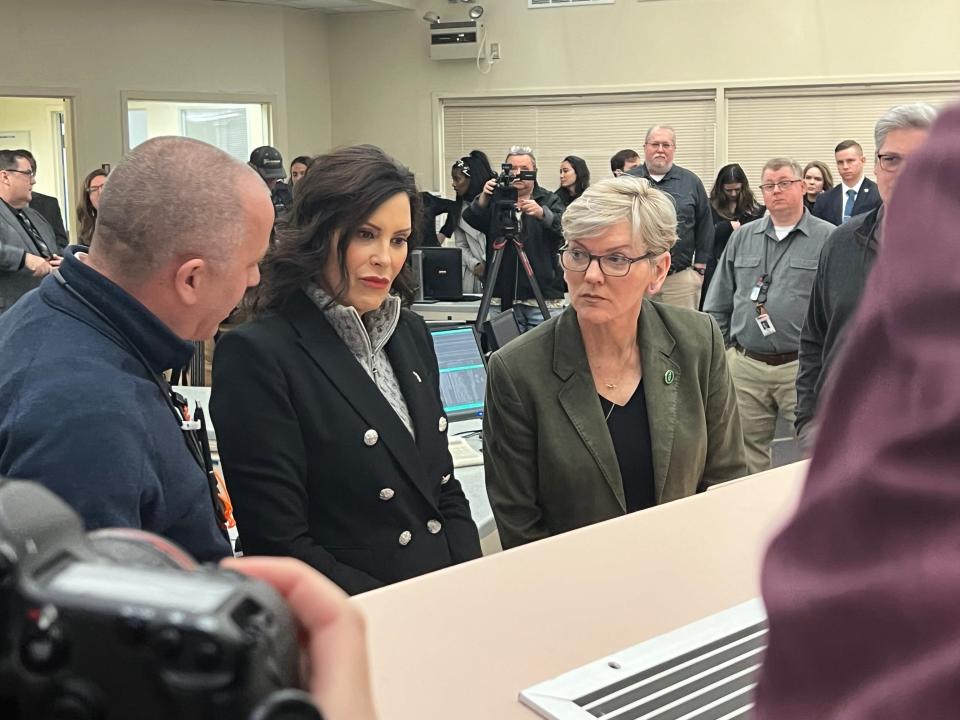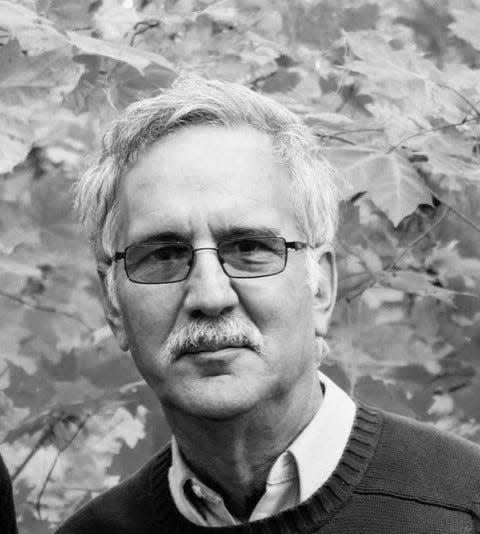The government is spending billions to restart Michigan's Palisades reactor. Why? | Opinion
- Oops!Something went wrong.Please try again later.
In 1954, Atomic Energy Commissioner Lewis Strauss — a financier recently portrayed by Robert Downey Jr. in the film "Oppenheimer" — promised a group of science writers that nuclear power would be "too cheap to meter."
True believers in Michigan have found out the hard way that he was wrong.
Our state got off to a bad start with the experimental Fermi 1 “fast breeder” nuclear plant near Monroe. Shortly after going online in 1966, it delivered little power, quickly suffered a meltdown and was shut down. Nine years later, this terrifying top-secret story was finally revealed in John G. Fuller’s 1975 book "We Almost Lost Detroit." Total loss in today’s dollars: $980 million.
After the Big Rock Point experimental reactor near Petoskey closed in 1997, officials realized the backup pump system had been disabled for as long as 14 years.
Then, in 2022, one of the nation’s most experienced atomic power plant operators, Entergy, shut down the Palisades plant in Covert Township, ahead of schedule — driven, says Mark Jacobson, a professor of civil and environmental engineering at Stanford University and director of its Atmosphere/Energy Program, by the need for, and high cost of, upgrades to the plant.
Last month, U.S. Department of Energy Secretary Jennifer Granholm and Gov. Gretchen Whitmer told a Covert Township audience that Washington and Lansing are making the down payment on a program to restart — the first time any nuclear plant has been re-started — the Palisades plant that will cost billions. The big first step is a $1.5 billion federal loan. The Michigan Legislature has already approved a $150 million subsidy, and is now considering doubling this amount. It's the first time any nuclear plant has been re-started.
Opinion: To run for president in 2028, Gretchen Whitmer must deliver Michigan in 2024
The National Regulatory Commission is holding a public meeting Wednesday at 6 p.m. to discuss the plans.
Evidence from around the country shows that renewable energy like solar and wind is more efficient, with less risk.
Whitmer, the Michigan Legislature and Granholm should quickly abandon the wasteful and counterproductive plan to restart Palisades, and invest in renewable energy instead.
Expensive and risky
It's time-consuming and costly to build new nuclear reactors — only three American nuclear power plants have opened in the 21st century. One in Tennessee took 42 years to complete. Industry leader Westinghouse went bankrupt on reactor projects in Georgia and South Carolina.
Jacobson says the cost of nuclear power from America’s two most recently opened plants in Georgia is $16/watt: “That does not compare favorably with onshore wind, which can be as low as $1 a watt and utility-scale solar, 70 cents a watt.”
New nuclear power plants can take nine to 15 years for construction, and 17 to 22 years overall from planning to operation in the U.S. and Europe, and 12 to 22 years worldwide. Georgia’s new Vogtle plants were finished seven years late and $17 billion over budget. New wind and solar facilities take one to three years to complete.
More from Opinion: She was 17 and needed an abortion. Ending parental consent law would help.
As a result, customers are stuck with higher energy costs. Medical studies have shown that Ukraine’s Chernobyl disaster caused many cancers. Nuclear power may be more environmentally friendly than coal, but it can’t compare to wind, solar and other renewables.
“The clean nuclear power argument from the Nuclear Regulatory Commission and the Department of Energy is nonsense,” Jacobson said in an interview. “Mined uranium does not show up in perfect form. It must be refined, which takes a lot of energy and causes pollution. Nuclear reactors are belching huge amounts of water vapor and heat, contributing to local and global warming. Evaporated water from the giant steam generators is a greenhouse gas.
“New nuclear power plants cost 2.3 to 7.4 times those of onshore wind or utility solar PV per kWh, take five to 17 years longer between planning and operation, and produce nine to 37 times the emissions per kWh as wind.”
Other states are turning to renewable energy
So strong is the case for renewables that states like Illinois and California have opted against building new reactors, instead choosing to lengthen the lives of inefficient old reactors as they transition to renewables.
“New York spent $7 billion to add 12 years to the life of three reactors,” Jacobson says. “Considering the fact that these reactors will be replaced by wind and solar in a few years, it would have been far less expensive and better for the environment if that money had gone directly into renewables.”
Many of the biggest deferred maintenance problems at this fixer-upper were summarized in former owner Consumer’s Energy 2006 briefing to state regulators. At the time, the utility explained it was eager to “shed nuclear operating risk, industry risk, financial risk, nuclear risk (and) potentially significant future capital expenditure.”

New owner, old problems
Eighteen years later, many of those worries confront new owner Holtec International, which originally bought Palisades to decommission it.
Steam generator corrosion has accelerated since the 2022 Entergy shutdown. Cracking dry storage casks filled with radioactive waste are stored on the Lake Michigan shoreline.
Critics fear that restarting Palisades is a path to putting other old, obsolete and potentially dangerous reactors around the country online.
Jacobson says this unprecedented subsidy to Holtec, a company that has never built or operated a nuclear reactor, would be far better spent on renewables. He also questions the one-year timeline to restart Palisades.
“Not refurbishing the plant and trying to open it quickly could be risky," he said. "For example, in Canada, the four operating Darlington nuclear reactors were closed for refurbishment. It has been taking four years for each reactor. Palisades could easily take that much time or longer.
“Under the new Palisades plan, you would be spending billions on a plant that is not generating power for years,” Jacobson added.
Alternatives that would generate wind and solar energy could be up and running in a few years, he said, and "have none of the safety risks associated with nuclear power accidents. And unlike nuclear power, they actually produce carbon- and pollution- free energy."
Considering that no power company in the world has tried to restart a nuclear plant set for decommissioning, bringing Palisades back from the dead is a risky experiment that could be against Michigan's best interests.
“If and when Palisades ever restarts, you still have to face the fact that it’s an old plant that will have to be shut down in a few years, and be replaced by wind and solar," Jacobson said.
There's another option
Wasting billions on a Palisades restart sidesteps a far better solution, developed by Jacobson, that would directly lead Michigan to a zero-carbon future energy transition. With significant investment, Jacobson wrote, this wind-water-solar supply and storage approach would fulfill all of the state’s energy needs with zero pollution.
All upfront costs would be paid back through energy sales, Jacobson wrote. Not only does this approach reduce energy costs by 62%, Jacobson believes it would create jobs during the construction and long term. Because renewable energy is stored in batteries, it stabilizes the grid, Jacobson said — as California has increased its use of renewables, blackouts diminished dramatically.
Taking this pressure off the grid would mean fewer blackouts or brownouts, or safety concerns about nuclear reactor failures, Jacobson said. Requiring just 0.81% of Michigan land for the power producing footprint, this renewable approach eliminates 89 million tonnes of CO₂ per year.
We have to listen to experts like Jacobson, whose far more affordable renewables plan promises to usher in a much safer green energy era for our state.

Roger Rapoport, who lives near Palisades, has covered the nuclear energy industry for many years. He is the author of the new book Searching For Patty Hearst. Submit a letter to the editor at freep.com/letters, and we may publish it online and in print.
This article originally appeared on Detroit Free Press: Michigan's Palisades nuclear reactor restart will be expensive, risky

